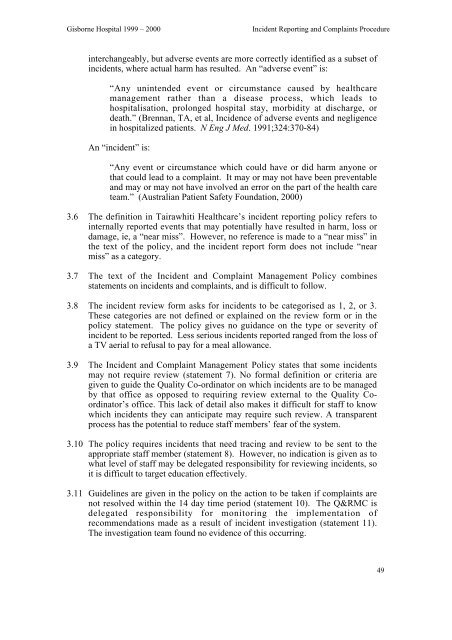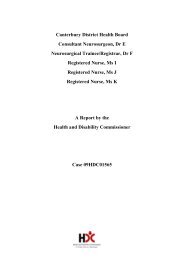Gisborne Hospital Report - Health and Disability Commissioner
Gisborne Hospital Report - Health and Disability Commissioner
Gisborne Hospital Report - Health and Disability Commissioner
You also want an ePaper? Increase the reach of your titles
YUMPU automatically turns print PDFs into web optimized ePapers that Google loves.
<strong>Gisborne</strong> <strong>Hospital</strong> 1999 – 2000<br />
Incident <strong>Report</strong>ing <strong>and</strong> Complaints Procedure<br />
interchangeably, but adverse events are more correctly identified as a subset of<br />
incidents, where actual harm has resulted. An “adverse event” is:<br />
“Any unintended event or circumstance caused by healthcare<br />
management rather than a disease process, which leads to<br />
hospitalisation, prolonged hospital stay, morbidity at discharge, or<br />
death.” (Brennan, TA, et al, Incidence of adverse events <strong>and</strong> negligence<br />
in hospitalized patients. N Eng J Med. 1991;324:370-84)<br />
An “incident” is:<br />
“Any event or circumstance which could have or did harm anyone or<br />
that could lead to a complaint. It may or may not have been preventable<br />
<strong>and</strong> may or may not have involved an error on the part of the health care<br />
team.” (Australian Patient Safety Foundation, 2000)<br />
3.6 The definition in Tairawhiti <strong>Health</strong>care’s incident reporting policy refers to<br />
internally reported events that may potentially have resulted in harm, loss or<br />
damage, ie, a “near miss”. However, no reference is made to a “near miss” in<br />
the text of the policy, <strong>and</strong> the incident report form does not include “near<br />
miss” as a category.<br />
3.7 The text of the Incident <strong>and</strong> Complaint Management Policy combines<br />
statements on incidents <strong>and</strong> complaints, <strong>and</strong> is difficult to follow.<br />
3.8 The incident review form asks for incidents to be categorised as 1, 2, or 3.<br />
These categories are not defined or explained on the review form or in the<br />
policy statement. The policy gives no guidance on the type or severity of<br />
incident to be reported. Less serious incidents reported ranged from the loss of<br />
a TV aerial to refusal to pay for a meal allowance.<br />
3.9 The Incident <strong>and</strong> Complaint Management Policy states that some incidents<br />
may not require review (statement 7). No formal definition or criteria are<br />
given to guide the Quality Co-ordinator on which incidents are to be managed<br />
by that office as opposed to requiring review external to the Quality Coordinator’s<br />
office. This lack of detail also makes it difficult for staff to know<br />
which incidents they can anticipate may require such review. A transparent<br />
process has the potential to reduce staff members’ fear of the system.<br />
3.10 The policy requires incidents that need tracing <strong>and</strong> review to be sent to the<br />
appropriate staff member (statement 8). However, no indication is given as to<br />
what level of staff may be delegated responsibility for reviewing incidents, so<br />
it is difficult to target education effectively.<br />
3.11 Guidelines are given in the policy on the action to be taken if complaints are<br />
not resolved within the 14 day time period (statement 10). The Q&RMC is<br />
delegated responsibility for monitoring the implementation of<br />
recommendations made as a result of incident investigation (statement 11).<br />
The investigation team found no evidence of this occurring.<br />
49
















